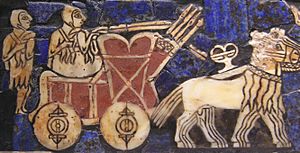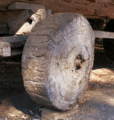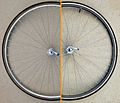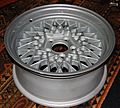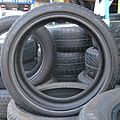Wheel facts for kids
A wheel is a round, spinning tool. Its main job is to help things roll easily across the ground. Think of it as a simple machine that makes moving heavy objects much simpler!
History of the Wheel
It's a bit of a mystery exactly when and where the wheel was first invented. Some old ideas suggest it started in Mesopotamia (modern-day Iraq). However, newer ideas suggest it might have been invented in both Mesopotamia and Eastern Europe around the same time. It's also possible that different groups of people invented the wheel on their own, without knowing about others. We've found signs of early wheeled carts in places like the Middle East, Europe, India, and China.
The first wheels were solid wooden disks. They appeared in the late Neolithic period, which was a long time after people started farming and making pottery.
Here's a timeline of important wheel inventions:
- 4500–3300 BCE (Copper Age): The potter's wheel was invented. This was a spinning wheel used to shape clay. The first solid wooden wheels and wheeled vehicles also appeared around this time. Horses were also tamed.
- 3300–2200 BCE (Early Bronze Age): Wheels became more common.
- 2200–1550 BCE (Middle Bronze Age): The spoked wheel was invented. This led to lighter, faster vehicles like the chariot.
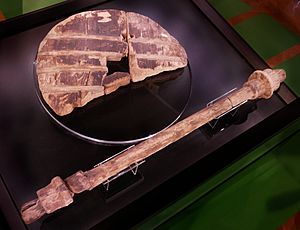
Before true wheels, people used "slow wheels" or "tournettes" for pottery. These were stone or clay disks that spun slowly. Real potter's wheels, which spin freely with an axle, were developed in Mesopotamia around 4200–4000 BCE. The oldest surviving example was found in Ur (Iraq) and is from about 3100 BCE.
The first hints of wheeled movement were tiny clay wheels found north of the Black Sea before 4000 BCE. By the mid-3000s BCE, we see more evidence of wheels across Europe, like toy cars and pictures. In Mesopotamia, pictures of wheeled wagons were found on clay tablets from around 3500–3350 BCE.
One of the oldest pictures of a wheeled vehicle is on a clay pot found in southern Poland, dating to between 3631 and 3380 BCE. The oldest actual wheel and axle found together is the Ljubljana Marshes Wooden Wheel in Slovenia, from about 3340–3030 BCE.
Early wheels were simple wooden disks, often cut from tree trunks. Later, people learned to make them from rounded pieces of wood, which made them stronger.
The spoked wheel was a big step forward. It made wheels much lighter and faster. The earliest known spoked wheels are from around 2000 BCE. Soon after, horse-drawn war chariots with spoked wheels became common. The Celts later added an iron rim around their chariot wheels, making them even stronger.
In China, wheel tracks from around 2200 BCE have been found. The first spoked wheels in China appeared between 2000 and 1500 BCE. In Britain, a large wooden wheel from 1100 to 800 BCE was found in 2016. It was likely part of a horse-drawn cart.

In the Americas, before Europeans arrived, wheels were not used for big tasks. However, many small wheeled toys have been found in Mexico, some from around 1500 BCE. One reason wheels weren't used for transport might be that there weren't many large animals that could pull carts. The llama was the only large animal tamed, but it wasn't strong enough for pulling heavy vehicles.
In Nubia (an ancient region in Africa), people used wheels for spinning pottery and for water wheels (around 400 BCE). Nubians also used horse-drawn chariots. In West Africa, wheeled vehicles were mostly used for special ceremonies until the 1800s.
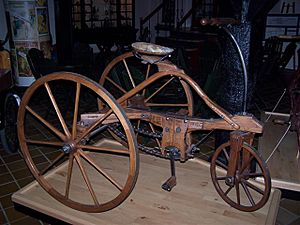
Spoked wheels were used for a long time without big changes. Then, in the 1870s, wire-spoked wheels and pneumatic tires (tires filled with air) were invented. Air-filled tires made riding much smoother and easier. Wire spokes are strong and light. Today, many vehicles use cast alloy wheels, which are made from a mix of metals.
The invention of the wheel also led to many other important technologies. These include the water wheel (used to power mills), cogwheels (found in clocks and machines), the spinning wheel (for making thread), and even parts of early astronomical tools. More modern inventions that use the idea of a spinning wheel include the propeller, the jet engine, and the turbine.
Modern Uses
Today, wheels are everywhere! You can find them on cars, carts, airplanes, wheelchairs, bicycles, trains, caravans, and skateboards. Wheels are usually used in pairs, connected by a rod called an axle.
Related pages
Images for kids
-
Spoked wheel with bronze sheeting from Árokalja, 1000 BC.
-
Radially- (left) and tangentially- (right) wire-spoked wheels, both with pneumatic tires.
-
Cast alloy wheel on a folding bicycle, with a pneumatic tire.
-
An aluminium alloy wheel.
-
A spoked wheel on display at The National Museum of Iran, in Tehran. The wheel is dated to the late 2nd millennium BCE and was excavated at Choqa Zanbil.
See also
 In Spanish: Rueda para niños
In Spanish: Rueda para niños


